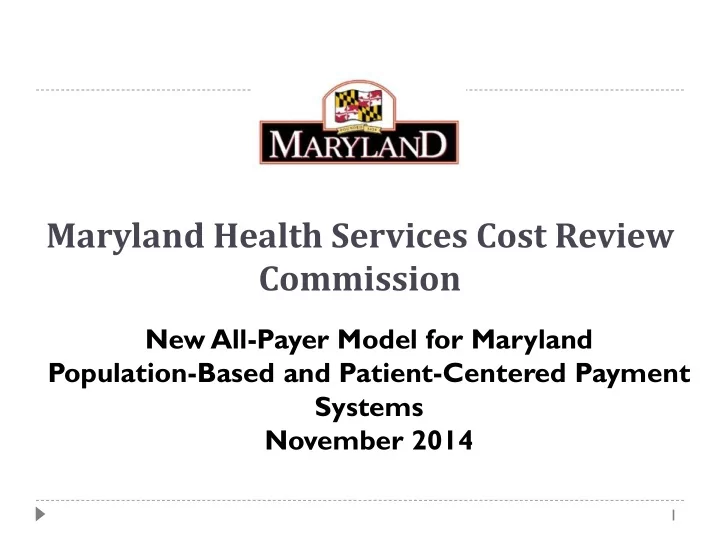

Maryland Health Services Cost Review Commission New All-Payer Model for Maryland Population-Based and Patient-Centered Payment Systems November 2014 1
Approved New All-Payer Model Maryland is implementing a new All-Payer Model for hospital payment Updated application submitted to Center for Medicare and Medicaid Innovation in October 2013 Approved effective January 1, 2014 Focus on new approaches to rate regulation Moves Maryland From Medicare , inpatient, per admission test To an all payer , total hospital payment per capita test Shifts focus to population health and delivery system redesign 2
New All-Payer Model for Maryland Focus shifts to the patient and improvement of care Align payment with new ways of Better care organizing and providing care Contain growth in total cost of Better health hospital care in line with requirements Lower cost Evolve value payments around efficiency, health and outcomes 3
Approved Model Timeline Phase 1 - 5 Year Hospital Model Maryland all-payer hospital model Developing in alignment with the broader health care system Phase 2 – Total Cost of Care Model Phase 1 efforts will come together in a Phase 2 proposal To be submitted in Phase 1, End of Year 3 Implementation beyond Year 5 will further advance the three-part aim 4
Approved Model at a Glance All-Payer total hospital per capita revenue growth ceiling for Maryland residents tied to long term state economic growth (GSP) per capita 3.58% annual growth rate Medicare payment savings for Maryland beneficiaries compared to dynamic national trend. Minimum of $330 million in savings Patient and population centered-measures and targets to promote population health improvement Medicare readmission reductions to national average 30% reduction in preventable conditions under Maryland’s Hospital Acquired Condition program (MHAC) over a 5 year period Quality revenue at risk to equal or exceed national Medicare programs 5
Focus Shifts from Rates to Revenues New Model Old Model Population and Value Driven Volume Driven Units/Cases Revenue Base Year Rate Per Updates for Trend, Unit or Case Population, Value Allowed Hospital Revenue Revenue Target Year Unknown at the beginning of Known at the beginning of year. year. More units/more revenue More units does not create more revenue 6
Opportunities for Success Under the New All-Payer Model 7
Opportunities for Success Improved care • • Global revenue budgets providing stable Delivery System Objectives and value for model for transition and reinvestment patients Model Opportunities • Lower use — reduce avoidable utilization with • Sustainable effective care management and quality delivery system improvement for efficient and effective • Focus on reducing Medicare cost hospitals Alignment with • • Integrate population health approaches physician delivery and • Control total cost of care payment model changes • Rethink the business model/capacity and innovate • Align with physicians and other providers 8
Reduce Avoidable Utilization By Improving Care Examples: 30- Day Readmissions/Rehospitalizations Preventable Admissions (based on AHRQ Prevention Quality Indicators) Nursing home residents — Reduce conditions leading to admissions and readmissions Maryland Hospital Acquired Conditions (potentially preventable complications) Improved care coordination: particular focus on high needs/frequent users, involvement of social services 9
Community Benefits The IRS requires non-profit hospitals nationally to report on their expenditures, community health needs assessments, and how community benefits programs are organized. The HSCRC receives a very similar report and makes it available to the public. FY 2013 was the first year that all hospitals were required to conduct a community health needs assessment. HSCRC Report requirements encourage collaboration with community stakeholders and other hospitals FY 2013 net hospital CB expenditure was 712.4 million or 5.2% of total operating expenses. 10
Public Engagement Process – Phase 2 HSCRC Multi Agency and Stakeholder Activities Advisory Council Consumer Care Coordination Engagement / Alignment Initiatives and Models Outreach and Infrastructure Education Performance Payment Models Measurement Ad Hoc Subgroups GBR Physician Consumer Medicaid Total Cost of Transfers Rev/Budget Alignment Engagement Assessment Care Corridor GBR Communications Market GBR Infrastructure LTC/Post Acute Monitoring Efficiency and Community Template Share Investment Rpt Outreach 11
Recommend
More recommend